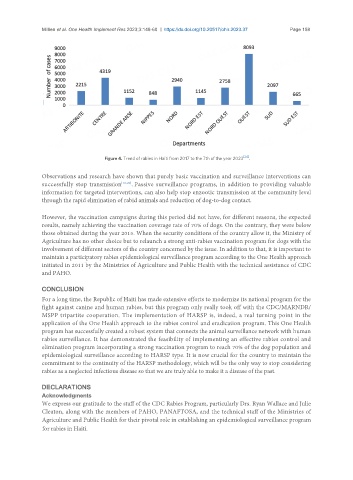Page 92 - Read Online
P. 92
Millien et al. One Health Implement Res 2023;3:148-60 https://dx.doi.org/10.20517/ohir.2023.37 Page 158
[24]
Figure 4. Trend of rabies in Haiti from 2017 to the 7th of the year 2023 .
Observations and research have shown that purely basic vaccination and surveillance interventions can
successfully stop transmission [18-20] . Passive surveillance programs, in addition to providing valuable
information for targeted interventions, can also help stop enzootic transmission at the community level
through the rapid elimination of rabid animals and reduction of dog-to-dog contact.
However, the vaccination campaigns during this period did not have, for different reasons, the expected
results, namely achieving the vaccination coverage rate of 70% of dogs. On the contrary, they were below
those obtained during the year 2015. When the security conditions of the country allow it, the Ministry of
Agriculture has no other choice but to relaunch a strong anti-rabies vaccination program for dogs with the
involvement of different sectors of the country concerned by the issue. In addition to that, it is important to
maintain a participatory rabies epidemiological surveillance program according to the One Health approach
initiated in 2011 by the Ministries of Agriculture and Public Health with the technical assistance of CDC
and PAHO.
CONCLUSION
For a long time, the Republic of Haiti has made extensive efforts to modernize its national program for the
fight against canine and human rabies, but this program only really took off with the CDC/MARNDR/
MSPP tripartite cooperation. The implementation of HARSP is, indeed, a real turning point in the
application of the One Health approach to the rabies control and eradication program. This One Health
program has successfully created a robust system that connects the animal surveillance network with human
rabies surveillance. It has demonstrated the feasibility of implementing an effective rabies control and
elimination program incorporating a strong vaccination program to reach 70% of the dog population and
epidemiological surveillance according to HARSP type. It is now crucial for the country to maintain the
commitment to the continuity of the HARSP methodology, which will be the only way to stop considering
rabies as a neglected infectious disease so that we are truly able to make it a disease of the past.
DECLARATIONS
Acknowledgments
We express our gratitude to the staff of the CDC Rabies Program, particularly Drs. Ryan Wallace and Julie
Cleaton, along with the members of PAHO, PANAFTOSA, and the technical staff of the Ministries of
Agriculture and Public Health for their pivotal role in establishing an epidemiological surveillance program
for rabies in Haiti.

